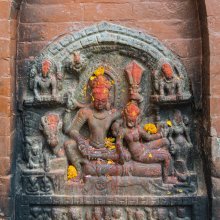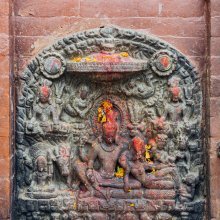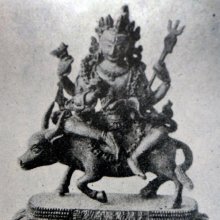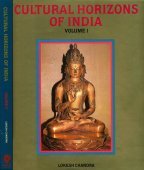Maheshvara, Maheśvara, Māheśvara, Maha-ishvara: 34 definitions
Introduction:
Maheshvara means something in Buddhism, Pali, Hinduism, Sanskrit, Jainism, Prakrit, the history of ancient India, Hindi. If you want to know the exact meaning, history, etymology or English translation of this term then check out the descriptions on this page. Add your comment or reference to a book if you want to contribute to this summary article.
The Sanskrit terms Maheśvara and Māheśvara can be transliterated into English as Mahesvara or Maheshvara, using the IAST transliteration scheme (?).
Images (photo gallery)
(+7 more images available)
In Hinduism
Purana and Itihasa (epic history)
Source: archive.org: Puranic EncyclopediaMaheśvara (महेश्वर).—Another name of Śiva.
Source: archive.org: Shiva Purana - English Translation1) Maheśvara (महेश्वर) refers to one of the eight names of Śiva (śivanāma) and is mentioned in the Śivapurāṇa 1.20 while explaining the mode of worshipping an earthen phallic image (pārthiva-liṅga) according to the Vedic rites:—“[...] the eight names of Śiva viz:—Hara, Maheśvara, Śambhu, Śūlapāṇi, Pinākadhṛk, Śiva, Paśupati and Mahādeva shall be used respectively for the rites of bringing the clay, kneading, installation, invocation, ceremonial ablution, worship, craving the forbearance and ritualistic farewell. Each of the names shall be prefixed with Oṃkāra. The name shall be used in the dative case and Namaḥ shall be added to them. The rites shall be performed respectively with great devotion and joy. [...]”.
2) Māheśvara (माहेश्वर) refers to a “devotee of Lord Śiva”, as mentioned in the Śivapurāṇa 2.1.18.—Accordingly, “[...] in the meantime a certain devotee of Lord Śiva [viz., māheśvara] came out of the city taking with him various articles of offering (upahāra). He had observed fast (uposhita) on the Śivarātri day. In order to worship lord Śiva, he was on his way, along with his kinsmen and was carrying different sorts of delightful offerings. [...]”.
Source: Cologne Digital Sanskrit Dictionaries: The Purana Index1a) Maheśvara (महेश्वर).—(Śiva): cursed the seven sages to be born in every epoch;1 got vṛṣa (bull) from Surabhī for his standard;2 lived long in his father-in-law's house after marriage; Meru insulted him as poor and useless when Umā insisted on her husband to go to his house; he went to Benares after which it became Avimukta;3 also Brahmā;4 Stambha; Kāpāli on earth for having removed one face of Brahmā; to get rid of this brahmicide Śiva's service to Kāmākṣī at Kāñcī; blessed for his samādhi; bathed in Pañcasaras and found himself at Kāśi, from there to Kāñcī; Jyotirmayibhikṣa given; the Kapāla dropped out and he was relieved;5 blessed Kubera to be the lord of the Yakṣas for his penance at the confluence of the Narmadā and the Kāverī.6 Praise of, by Kāvya.7
- 1) Brahmāṇḍa-purāṇa II. 27. 47; III. 1. 9.
- 2) Ib. III. 3. 78-79.
- 3) Ib. III. 31. 35. 67. 32, 60.
- 4) Ib. IV. 1. 203; 2. 221, 257; 4. 35, 73; 7. 49; 14. 18.
- 5) Ib. IV. 40. 52-59.
- 6) Matsya-purāṇa 181. 3-5; 185. 12; 189. 10.
- 7) Vāyu-purāṇa 97, 162-202.
1b) As cosmos; hence acintyātma but the source of all beings; Brahmanas from face, Kṣatriyas, from breast, Vaiśyas from the thighs and Śūdras from the feet;1 created the world, men, devas, asuras, constellation, night, day, Vedas, etc.;2 the smallest atom among the prakṛtis, never failing, absolute; formless, and of form; the darkness becomes illumination by the contact of tejas;3 the six angas of; all wise, all satiating, ever arousing, all free, eternally powerful, and of undiminished strength;4 a Mahāyogi;5 Lokeśa, worshipped in different ways.6
- 1) Vāyu-purāṇa 9. 122.
- 2) Brahmāṇḍa-purāṇa I. 5. 95.
- 3) Vāyu-purāṇa 101. 226.
- 4) Ib. 12. 31-3.
- 5) Ib. 21. 36.
- 6) Ib. 49. 171.
1c) Born of Pradhāna and Puruṣa; father of world creation;1 the universe as limbs of.2
2) Māheśvara (माहेश्वर).—The 29th Kalpa in which Tripuram was burnt.*
- * Matsya-purāṇa 290. 10.
Maheśvara (महेश्वर) is a name mentioned in the Mahābhārata (cf. XIV.8.27, XIV.8) and represents one of the many proper names used for people and places. Note: The Mahābhārata (mentioning Maheśvara) is a Sanskrit epic poem consisting of 100,000 ślokas (metrical verses) and is over 2000 years old.
Source: Shodhganga: The saurapurana - a critical studyMaheśvara (महेश्वर) is the deity to be worshipped in the month Magha for the Anaṅgatrayodaśī-Vrata, according to the 10th century Saurapurāṇa: one of the various Upapurāṇas depicting Śaivism.—Accordingly, the Anaṅgatrayodaśī-vrata is observed in honour of Śiva for acquiring virtue, great fortune, wealth and for destruction of sins [...] This vrata is to be performed for a year from Mārgaśīra.—In the month of Magha the tooth-brush is of vaṭa, food is milk, the deity to be worshipped is Maheśvara and the result is eight times that of gomedha sacrifice.
Source: Shodhganga: Elements of Art and Architecture in the Trtiyakhanda of the VisnudharmottarapuranaMāheśvara (माहेश्वर) or Māheśvarapurāṇa refers to one of the eighteen Minor Puranas (i.e., Upapurāṇa) according to the Kūrmapurāṇa and other traditional lists of Puranic literature: a category of ancient Sanskrit texts which gives a huge contribution in the development of Indian literature.—The Upapurāṇas (e.g., māheśvara-purāṇa) can be considered as the supplements of the Mahāpurāṇas as those are mostly based on the Mahāpurāṇas. The Saurapurāṇa considers the Upapurāṇas as khilas i.e., supplements. [...] Though the numbers of Upapurāṇas are specified as eighteen, there are many important Upapurāṇas which are excluded from the lists of Upapurāṇas given by different sources.

The Purana (पुराण, purāṇas) refers to Sanskrit literature preserving ancient India’s vast cultural history, including historical legends, religious ceremonies, various arts and sciences. The eighteen mahapuranas total over 400,000 shlokas (metrical couplets) and date to at least several centuries BCE.
Natyashastra (theatrics and dramaturgy)
Source: Wisdom Library: Nāṭya-śāstraMaheśvara (महेश्वर) is the Sanskrit name for a deity to be worshipped during raṅgapūjā, according to the Nāṭyaśāstra 3.1-8. Accordingly, the master of the dramatic art who has been initiated for the purpose shall consecrate the playhouse after he has made obeisance (e.g., to Maheśvara).

Natyashastra (नाट्यशास्त्र, nāṭyaśāstra) refers to both the ancient Indian tradition (shastra) of performing arts, (natya—theatrics, drama, dance, music), as well as the name of a Sanskrit work dealing with these subjects. It also teaches the rules for composing Dramatic plays (nataka), construction and performance of Theater, and Poetic works (kavya).
Shaivism (Shaiva philosophy)
Source: Wisdom Library: Śaivism1) Maheśvara (महेश्वर) is a Sanskrit word referring to one of the sixty-eight places hosting a svāyambhuvaliṅga, one of the most sacred of liṅgas according to the Śaivāgamas. The presiding deity residing over the liṅga in this place (Maheśvara) is named Oṃkāra.
2) Maheśvara (महेश्वर) is also the name of a deity presiding over Prayāga, Viśvamadhya and Dīpta, three of the sixty-eight places hosting a svāyambhuvaliṅga, which is one of the most sacred of liṅgas according to the Śaivāgamas.
The list of sixty-eight svāyambhuvaliṅgas and presiding deities is found in the commentary on the Jirṇoddhāra-daśaka by Nigamajñānadeva. The word liṅga refers to a symbol used in the worship of Śiva and is used thoughout Śaiva literature, such as the sacred Āgamas.
Source: DSpace at Pondicherry: Siddha Cult in Tamilnadu (shaivism)Maheśvara (महेश्वर).—There existed yet another group of Siddhas from the South known as Maheśvara Siddhas. They advocate the pure method (śuddha-mārga). Because, the dakṣiṇa-śrota (the right current), stressed on vidyā (knowledge) through yogic practices, instead of using the five ‘m’s as used by the vāma-śrota (left current), which include blood sacrifices, drinking and female consorts. The Tamil Siddhas belong to the dakśiṇa-śrota.
Source: Brill: Śaivism and the Tantric Traditions (philosophy)Maheśvara (महेश्वर) refers to the “Great Lord”, according to the Īśvarapratyabhijñākārikā 1.1.2.—Accordingly, “What conscious Self could produce either a refutation or a demonstration [of the existence] of the agent, the knowing subject, the always already established Self, the Great Lord (maheśvara)?”

Shaiva (शैव, śaiva) or Shaivism (śaivism) represents a tradition of Hinduism worshiping Shiva as the supreme being. Closely related to Shaktism, Shaiva literature includes a range of scriptures, including Tantras, while the root of this tradition may be traced back to the ancient Vedas.
Kavya (poetry)
Source: Wisdom Library: KathāsaritsāgaraMaheśvara (महेश्वर) is mentioned in as the “chief of things animate and inanimate”. His dwelling place is the mountain-peak Kailāsa, located within Himavat, according to the Kathāsaritsāgara, chapter 1. Accordingly, “There (Kailāsa) dwells Maheśvara the beloved of Pārvatī, the chief of things animate and inanimate, attended upon by Gaṇas, Vidyādharas and Siddhas. In the upstanding yellow tufts of his matted hair the new moon enjoys the delight of touching the eastern mountain yellow in the evening twilight.”
The Kathāsaritsāgara (‘ocean of streams of story’), mentioning Maheśvara, is a famous Sanskrit epic story revolving around prince Naravāhanadatta and his quest to become the emperor of the vidyādharas (celestial beings). The work is said to have been an adaptation of Guṇāḍhya’s Bṛhatkathā consisting of 100,000 verses, which in turn is part of a larger work containing 700,000 verses.

Kavya (काव्य, kavya) refers to Sanskrit poetry, a popular ancient Indian tradition of literature. There have been many Sanskrit poets over the ages, hailing from ancient India and beyond. This topic includes mahakavya, or ‘epic poetry’ and natya, or ‘dramatic poetry’.
Pancaratra (worship of Nārāyaṇa)
Source: eScholarship: Chapters 1-14 of the Hayasirsa PancaratraMaheśvara (महेश्वर) is a name of Śiva, as mentioned in the 9th century Hayaśīrṣa-pañcarātra (Ādikāṇḍa chapter 1).—“[...] Formerly, it is told, Virūpākṣa-Maheśvara (i.e., Śiva) with Gaurī (i.e., Pārvatī) questioned the four-faced one (Brahmā) who was staying in the above of Vairāja”.

Pancaratra (पाञ्चरात्र, pāñcarātra) represents a tradition of Hinduism where Narayana is revered and worshipped. Closeley related to Vaishnavism, the Pancaratra literature includes various Agamas and tantras incorporating many Vaishnava philosophies.
Vaishnavism (Vaishava dharma)
Source: Pure Bhakti: Bhagavad-gita (4th edition)Maheśvara (महेश्वर) refers to “supreme Controller; it sometimes refers to Śambhu Śiva and sometimes to Bhagavān Śrī Kṛṣṇa”. (cf. Glossary page from Śrīmad-Bhagavad-Gītā).

Vaishnava (वैष्णव, vaiṣṇava) or vaishnavism (vaiṣṇavism) represents a tradition of Hinduism worshipping Vishnu as the supreme Lord. Similar to the Shaktism and Shaivism traditions, Vaishnavism also developed as an individual movement, famous for its exposition of the dashavatara (‘ten avatars of Vishnu’).
In Buddhism
Mahayana (major branch of Buddhism)
Source: Wisdom Library: Maha Prajnaparamita SastraMaheśvara (महेश्वर) is the name of a deity mentioned in the 2nd century Mahāprajñāpāramitāśāstra (chapter IV). Other individuals also know all the dharmas, e.g., Mo hi cheou lo (Maheśvara) [in the languag of Ts’in, ‘Great Lord’]: he has eight arms (aṣṭabhuja), three eyes (trinetra, tryakṣa) and he is mounted on a white bull (vṛṣavāhana) [Nandi]. All these gods are great guides (mahānāyaka). They cannot be omniscient. Why? Because their mind remains attached (abhiniviṣṭa) to hatred (dveṣa) and pride (abhhimāna).
Source: archive.org: Bulletin of the French School of the Far East (volume 5)Maheśvara (महेश्वर) is the name of a Devarṣi appointed as one of the Divine protector deities of Śaya, according to chapter 17 of the Candragarbha: the 55th section of the Mahāsaṃnipāta-sūtra, a large compilation of Sūtras (texts) in Mahāyāna Buddhism partly available in Sanskrit, Tibetan and Chinese.—In the Candragarbhasūtra, the Bhagavat invites all classes of Gods and Deities to protect the Law [dharma?] and the faithful in their respective kingdoms of Jambudvīpa [e.g., the Devarṣi Maheśvara in Śaya], resembling the time of the past Buddhas.

Mahayana (महायान, mahāyāna) is a major branch of Buddhism focusing on the path of a Bodhisattva (spiritual aspirants/ enlightened beings). Extant literature is vast and primarely composed in the Sanskrit language. There are many sūtras of which some of the earliest are the various Prajñāpāramitā sūtras.
Tibetan Buddhism (Vajrayana or tantric Buddhism)
Source: Wisdom Library: Tibetan BuddhismMaheśvara (महेश्वर) is the name of a Bodhisattva mentioned as attending the teachings in the 6th century Mañjuśrīmūlakalpa: one of the largest Kriyā Tantras devoted to Mañjuśrī (the Bodhisattva of wisdom) representing an encyclopedia of knowledge primarily concerned with ritualistic elements in Buddhism. The teachings in this text originate from Mañjuśrī and were taught to and by Buddha Śākyamuni in the presence of a large audience (including Maheśvara).
Source: archive.org: The Indian Buddhist IconographyMaheśvara (महेश्वर) is the name of a deity commonly depicted in Buddhist Iconography, and mentioned in the 11th-century Niṣpannayogāvalī of Mahāpaṇḍita Abhayākara.—His Colour is white; his Vehicle is the bull; he has four arms.
Maheśvara is described in the Niṣpannayogāvalī (dharmadhātuvāgīśvara-maṇḍala) as follows:—
Source: WikiPedia: Tibetan Buddhism“Maheśvara sits on the Bull, and is white in colour. His crown of matted hair is beautified by the moon. He is four-armed. With the two principal hands he displays the añjali over the head, and with the two others he carries the triśūla and the kapāla”.
Maheśvara (महेश्वर) (in Tibetan: Wangchug Che) (2127–2227 CE) refers to the twenty-third of the twenty-five Kalki kings (of Shambhala) who represents the holders of the Kalachakra (“wheel of time”) teachings of Buddha Shakyamuni.—The king Maheśvara is described as “victorious over the armies of demons”.

Tibetan Buddhism includes schools such as Nyingma, Kadampa, Kagyu and Gelug. Their primary canon of literature is divided in two broad categories: The Kangyur, which consists of Buddha’s words, and the Tengyur, which includes commentaries from various sources. Esotericism and tantra techniques (vajrayāna) are collected indepently.
In Jainism
General definition (in Jainism)
Source: Wisdom Library: JainismMaheśvara (महेश्वर) refers to a class of mahoraga deities gods according to the Digambara tradition, while the Śvetāmbara does not recognize this class. The mahoraga refer to a category of vyantaras gods which represents one of the four classes of celestial beings (devas). The mahoragas are are dark or black in complexion and the Nāga is their caitya-vṛkṣa (sacred-tree).
The deities such as the Maheśvaras are defined in ancient Jain cosmological texts such as the Saṃgrahaṇīratna in the Śvetāmbara tradition or the Tiloyapaṇṇati by Yativṛṣabha (5th century) in the Digambara tradition.
Source: archive.org: TrisastisalakapurusacaritraMaheśvara (महेश्वर) and Īśvara are the two Indras of the Bhūtavādita class Vyantaras living in the first 100 yojanas of the Ratnaprabhā-earth in the “lower world” (adhaloka), according to chapter 2.2 [ajitanātha-caritra] of Hemacandra’s 11th century Triṣaṣṭiśalākāpuruṣacaritra: an ancient Sanskrit epic poem narrating the history and legends of sixty-three illustrious persons in Jainism.
Accordingly: “[...] In the first 100 yojanas of Ratnaprabhā, with the exception of 10 above and 10 below, i.e., in 80 yojanas, there are 8 classes of Vyantaras: [viz., the Bhūtavāditas, ...] The two Indras in these classes are respectively: [viz., Īśvara and Maheśvara;...]”.

Jainism is an Indian religion of Dharma whose doctrine revolves around harmlessness (ahimsa) towards every living being. The two major branches (Digambara and Svetambara) of Jainism stimulate self-control (or, shramana, ‘self-reliance’) and spiritual development through a path of peace for the soul to progess to the ultimate goal.
India history and geography
Source: Cologne Digital Sanskrit Dictionaries: Indian Epigraphical GlossaryMaheśvara.—(SITI), Māheśvara, followers of the Śaiva reli- gion; a congregation of Śaiva devotees having a voice in the management of the affairs of a Śiva temple. (ASLV), trustee of a Śaiva temple. (IE 8-2), ‘devotee of Maheśvara (Śiva),’ epithet of a Kuṣāṇa king. Note: maheśvara is defined in the “Indian epigraphical glossary” as it can be found on ancient inscriptions commonly written in Sanskrit, Prakrit or Dravidian languages.
--- OR ---
Maheśvara.—(EI 28), the Pāśupta faith. Note: maheśvara is defined in the “Indian epigraphical glossary” as it can be found on ancient inscriptions commonly written in Sanskrit, Prakrit or Dravidian languages.

The history of India traces the identification of countries, villages, towns and other regions of India, as well as mythology, zoology, royal dynasties, rulers, tribes, local festivities and traditions and regional languages. Ancient India enjoyed religious freedom and encourages the path of Dharma, a concept common to Buddhism, Hinduism, and Jainism.
Languages of India and abroad
Sanskrit dictionary
Source: DDSA: The practical Sanskrit-English dictionaryMāheśvara (माहेश्वर).—a. (-rī f.)
1) Belonging to a great lord or to Śiva; अनेन च महाराज माहेश्वरमनुत्तमम् । इष्ट्वा यज्ञं (anena ca mahārāja māheśvaramanuttamam | iṣṭvā yajñaṃ) ... Rām. 6.7.19.
2) Worshipping Śiva.
-raḥ A worshipper of Śiva.
-rī Name of Pārvatī or Durgā.
--- OR ---
Maheśvara (महेश्वर).—
1) a great lord, sovereign; महेश्वरस्त्र्यम्बक एव नापरः (maheśvarastryambaka eva nāparaḥ) R.; गोप्तारं न निधीनां कथयन्ति महेश्वरं विबुधाः (goptāraṃ na nidhīnāṃ kathayanti maheśvaraṃ vibudhāḥ) Pañcatantra (Bombay) 2.74.
2) Name of Śiva.
3) of Viṣṇu.
4) a god (opp. prakṛti).
5) the Supreme Being (paramātmā); मायां तु प्रकृतिं विद्यान्मायिनं तु महेश्वरम् (māyāṃ tu prakṛtiṃ vidyānmāyinaṃ tu maheśvaram) Śvet. Up.4.1. °सखः (sakhaḥ) Name of Kubera; यया कैलासभवने महेश्वरसखं बली (yayā kailāsabhavane maheśvarasakhaṃ balī) Mahābhārata (Bombay) 9.11.55. (-rī) 1 Name of Durgā.
2) a kind of bell-metal.
Derivable forms: maheśvaraḥ (महेश्वरः).
Maheśvara is a Sanskrit compound consisting of the terms mahā and īśvara (ईश्वर).
Source: Cologne Digital Sanskrit Dictionaries: Edgerton Buddhist Hybrid Sanskrit DictionaryMaheśvara (महेश्वर).—(1) sg. or pl.; in Lalitavistara 112.3; 113.1, 11, a devaputra, evidently a leader of the śuddhāvāsakāyika gods, with whom he comes to salute the infant Bodhisattva and predict his future Buddhahood; in Mahāvastu i.224.3, 5 = ii.27.3, 5 (verses) pl., 8000 gods named Mah° come to cast the horoscope of the infant Bodhisattva; probably interpret in this sense maheśvara-rūpeṇa (the Bodhisattva, it is suggested, should enter his mother's womb thus) Lalitavistara 39.12; Mahāvyutpatti 3108 mahāmaheśvarāyatanam, q.v., a special stage of śuddhāvāsakāyika gods; (2) name of a yakṣa: Divyāvadāna 41.2 ff.; Suvarṇabhāsottamasūtra 161.6; Mahā-Māyūrī 9; (3) name of one or two Bodhisattva(s): Sādhanamālā 71.4 (here between Avalokite- śvara and Mahāsthāmaprāpta); Gaṇḍavyūha 442.6 (in a long, rigmarole list).
Source: Cologne Digital Sanskrit Dictionaries: Shabda-Sagara Sanskrit-English DictionaryMaheśvara (महेश्वर).—m.
(-raḥ) Siva. f. (-rī) 1. Durga the wife of Siva. 2. Mixed or bell-metal. 3. A flower, (Clitoria ternata.) E. mahā great, and īśvara God, fem. aff. ṅīṣ .
Source: Cologne Digital Sanskrit Dictionaries: Benfey Sanskrit-English DictionaryMaheśvara (महेश्वर).—m. Śiva.
Maheśvara is a Sanskrit compound consisting of the terms mahā and īśvara (ईश्वर).
Source: Cologne Digital Sanskrit Dictionaries: Cappeller Sanskrit-English DictionaryMaheśvara (महेश्वर).—[masculine] = [preceding], also [Epithet] of [several] other gods, [especially] of the 4 world-protectors; [feminine] ī [Epithet] of Durgā.
--- OR ---
Māheśvara (माहेश्वर).—[adjective] relating to great Śiva; [masculine] a Śivaite.
Source: Cologne Digital Sanskrit Dictionaries: Aufrecht Catalogus Catalogorum1) Maheśvara (महेश्वर) as mentioned in Aufrecht’s Catalogus Catalogorum:—guru of Kaiyaṭa.
2) Maheśvara (महेश्वर):—father of Bhāskarācārya (Siddhāntaśiromaṇi).
3) Maheśvara (महेश्वर):—poet. Mentioned in Bhojaprabandha Oxf. 150^b.
4) Maheśvara (महेश्वर):—on [dharma] Quoted in Saṃskārakaustubha.
5) Maheśvara (महेश्वर):—a medical author, quoted by Herambasena L. 206.
6) Maheśvara (महेश्वर):—Amarakośaviveka.
7) Maheśvara (महेश्वर):—Kāmaśāstra. Śp. p. 46.
8) Maheśvara (महेश्वर):—Keśavīvāsanābhāṣya. Yantrāja and—[commentary] Compare Mahendra. Laghujātakaṭīkā. Siddhāntaśiromaṇibhāṣya.
9) Maheśvara (महेश्वर):—Cityupaniṣadbhāṣya. Sahavaiupaniṣadbhāṣya.
10) Maheśvara (महेश्वर):—Caurapañcāśikāṭīkā. Prabodhacandrodayaṭīkā.
11) Maheśvara (महेश्वर):—Jīvanmuktiprakaraṇa.
12) Maheśvara (महेश्वर):—Tattvacintāmaṇiṭīkā. Tattvacintāmaṇidīdhitiṭīkā.
13) Maheśvara (महेश्वर):—Dāyabhāgaṭīkā.
14) Maheśvara (महेश्वर):—Dhūrtaviḍambana prahasana.
15) Maheśvara (महेश्वर):—
—[commentary] on Bhartṛhari’s Nītiśataka.
16) Maheśvara (महेश्वर):—Mahābhāratasaṃgraha.
17) Maheśvara (महेश्वर):—Mudrārākṣasaṭīkā.
18) Maheśvara (महेश्वर):—Raghuvaṃśaṭīkā.
19) Maheśvara (महेश्वर):—Rasārṇava med. Quoted in Rasendracintāmaṇi W. p. 299.
20) Maheśvara (महेश्वर):—son of Brāhma, grandson of Kṛṣṇa (Keśava): Viśvaprakāśa lex. composed in 1111. Śabdabhedaprakāśa or Śabdabhedanāmamālā, a sequel to the lexicon. Sāhasāṅkacarita. Quoted in the Preface to the Viśvaprakāśa. Oxf. 187^b.
21) Maheśvara (महेश्वर):—son of Manoratha: Vṛttaśataka jy.
22) Maheśvara (महेश्वर):—son of Virūpākṣa, wrote in 1590:
—[commentary] on Puruṣottama’s Viṣṇubhaktikalpalatā.
23) Māheśvara (माहेश्वर):—Sabhānāṭaka.
24) Maheśvara (महेश्वर):—father of Somanātha Bhaṭṭa (Ajñānadhvāntadīpikā).
25) Maheśvara (महेश्वर):—astronomer. Quoted L.. 1065-1067.
26) Maheśvara (महेश्वर):—C. on Bhartṛhari’s Nītiśataka.
27) Maheśvara (महेश्वर):—pupil of Svayamprakāśatīrtha: C. on the Rāmasahasranāman from the Liṅga-purāṇa.
Source: Cologne Digital Sanskrit Dictionaries: Monier-Williams Sanskrit-English Dictionary1) Maheśvara (महेश्वर):—[from mahā > mah] m. a great lord, sovereign, chief, [Śvetāśvatara-upaniṣad; Mahābhārata] etc. (with tridaśānām, ‘chief of the gods’ id est. Indra)
2) [v.s. ...] a god (opp. to prakṛti), [Śvetāśvatara-upaniṣad]
3) [v.s. ...] Name of various gods ([especially] of Śiva and of Kṛṣṇa; [plural] of the Loka-pālas or guardians of the world, viz. Indra, Agni, Yama and Varuṇa), [Mahābhārata; Rāmāyaṇa] etc.
4) [v.s. ...] of a Deva-putra, [Lalita-vistara]
5) [v.s. ...] of various authors and other men, [Inscriptions; Siddhāntaśiromaṇi; Catalogue(s)]
6) [v.s. ...] bdellium, [cf. Lexicographers, esp. such as amarasiṃha, halāyudha, hemacandra, etc.]
7) Māheśvara (माहेश्वर):—[from māhā] mf(ī)n. ([from] maheśvara) relating or belonging to the great lord Śiva, [Mahābhārata; Harivaṃśa; Purāṇa]
8) [v.s. ...] m. a worshipper of Śiva, [Harivaṃśa; Kathāsaritsāgara; Harṣacarita]
Source: Cologne Digital Sanskrit Dictionaries: Yates Sanskrit-English DictionaryMaheśvara (महेश्वर):—(raḥ) 1. m. Shiva. f. (rī) Durgā; bell-metal; a flower (Clitoria).
Source: DDSA: Paia-sadda-mahannavo; a comprehensive Prakrit Hindi dictionary (S)Maheśvara (महेश्वर) in the Sanskrit language is related to the Prakrit words: Mahissara, Mahesara, Māhesara.
[Sanskrit to German]
Sanskrit, also spelled संस्कृतम् (saṃskṛtam), is an ancient language of India commonly seen as the grandmother of the Indo-European language family (even English!). Closely allied with Prakrit and Pali, Sanskrit is more exhaustive in both grammar and terms and has the most extensive collection of literature in the world, greatly surpassing its sister-languages Greek and Latin.
Hindi dictionary
Source: DDSA: A practical Hindi-English dictionaryMāheśvara (माहेश्वर):—(a) pertaining to [maheśvara] (Lord Shiv).
...
Kannada-English dictionary
Source: Alar: Kannada-English corpusMahēśvara (ಮಹೇಶ್ವರ):—
1) [noun] Śiva, the Great or Supreme Lord.
2) [noun] (vīr.) the second of six stages in the path of development of a devotee; the stage in which the devotee comes to have trust and the resultant confidence in Śiva.
3) [noun] a devotee in this level.
4) [noun] (yoga.) the deity presiding over the sixth mystical circle in the human body.
--- OR ---
Māhēśvara (ಮಾಹೇಶ್ವರ):—
1) [noun] (vīr.) a devotee in the second of six stages in the path of development of a devotee (the stage in which the devotee comes to have trust and the resultant confidence in Śiva).
2) [noun] name of one of the Śaiva clans.
Kannada is a Dravidian language (as opposed to the Indo-European language family) mainly spoken in the southwestern region of India.
See also (Relevant definitions)
Partial matches: Ishvara, Maha.
Starts with (+27): Maheshvara bhatta, Maheshvara bhattacarya, Maheshvara mishra, Maheshvara nyayalamkara bhattacarya, Maheshvara sharman, Maheshvara-putra, Maheshvarabala, Maheshvarabhatta, Maheshvarabhattiya, Maheshvaradanta, Maheshvaradatta, Maheshvaradharma, Maheshvaradharmadharma, Maheshvaradhupa, Maheshvaradikshita, Maheshvaradikshitiya, Maheshvaradipa, Maheshvarajvara, Maheshvarakarachyuta, Maheshvarakaracyuta.
Ends with (+4): Atyanta-maheshvara, Bhutamaheshvara, Devasuramaheshvara, Dinmaheshvara, Hamsamaheshvara, Kadanamaheshvara, Laditamaheshvara, Lokamaheshvara, Mahamaheshvara, Odamaheshvara, Odramaheshvara, Parama-maheshvara, Rudra-maheshvara, Sarvalokamaheshvara, Shabdarashimaheshvara, Shri-maheshvara, Subuddhi mishra maheshvara, Subuddhimishramaheshvara, Svachandamaheshvara, Udaramaheshvara.
Full-text (+504): Mahamaheshvara, Maheshvari, Mahesha, Maheshvarakaracyuta, Upapurana, Pashutva, Sabhanataka, Maheshvaratva, Rudra-maheshvara, Parama-maheshvara, Mahesara, Shivabhagavata, Jvara, Maheshvarapada, Maheshvarata, Maheshvaratantra, Maheshvarapura, Duhkhanta, Vishvaprakasha, Maheshvaropapurana.
Relevant text
Search found 124 books and stories containing Maheshvara, Maha-ishvara, Mahā-īśvara, Maha-isvara, Maheśvara, Māheśvara, Mahesvara, Mahēśvara, Māhēśvara; (plurals include: Maheshvaras, ishvaras, īśvaras, isvaras, Maheśvaras, Māheśvaras, Mahesvaras, Mahēśvaras, Māhēśvaras). You can also click to the full overview containing English textual excerpts. Below are direct links for the most relevant articles:
Chaitanya Bhagavata (by Bhumipati Dāsa)
Verse 1.1.7 < [Chapter 1 - Summary of Lord Gaura’s Pastimes]
Verse 1.1.178 < [Chapter 1 - Summary of Lord Gaura’s Pastimes]
Verse 3.4.484 < [Chapter 4 - Descriptions of Śrī Acyutānanda’s Pastimes and the Worship of Śrī Mādhavendra]
Rudra-Shiva concept (Study) (by Maumita Bhattacharjee)
2. Rudra-Śiva in the Upaniṣadic Literature < [Chapter 4 - Rudra-Śiva in the Post-Brāhmaṇic Literature]
4. Forms of Śiva and his different activities < [Chapter 5 - Rudra-Śiva in the Purāṇic Literature]
2.3. Rudra as Śarva < [Chapter 6a - The Epithets of Rudra-Śiva]
Impact of Vedic Culture on Society (by Kaushik Acharya)
Chart: Religious beliefs of the Kings who ruled in Northern India < [Chapter 4]
Mingling of Cultures (C): The Maitrakas < [Chapter 4]
Religious Epithets (Brahmanical and Buddhist) < [Chapter 4]
Brihad Bhagavatamrita (commentary) (by Śrī Śrīmad Bhaktivedānta Nārāyana Gosvāmī Mahārāja)
Verse 2.3.75 < [Chapter 3 - Bhajana (loving service)]
Verse 2.4.226 < [Chapter 4 - Vaikuṇṭha (the spiritual world)]
Verse 2.3.62 < [Chapter 3 - Bhajana (loving service)]
Historical Elements in the Matsya Purana (by Chaitali Kadia)
Name of the Purāṇas < [Chapter 1 - An Introduction of the Purāṇas]
Varṇa (1): The Brāhmaṇas (Brahmins) < [Chapter 5 - Cultural history in the Matsya-Purāṇa]
Later Chola Temples (by S. R. Balasubrahmanyam)
Temples in Udaiyalur < [Chapter II - Temples of Kulottunga I’s Time]
Temples in Tirukkannapuram < [Chapter II - Temples of Kulottunga I’s Time]
Temples in Nagar < [Chapter X - Temples of Rajadhjraja II’s Time]
Related products
(+3 more products available)










